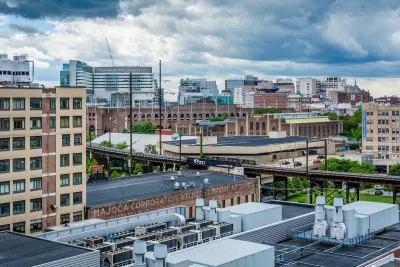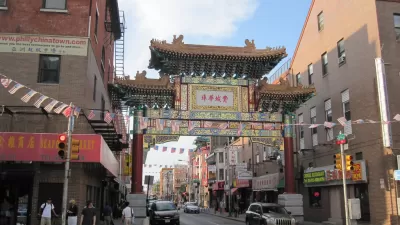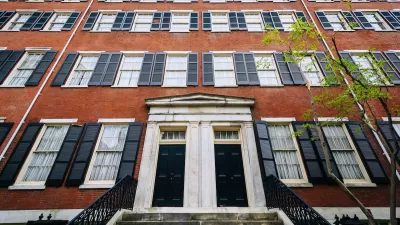How residents came together to fight for housing equity.

In the heart of Philadelphia, University City stands as a beacon of educational excellence and urban development, known for its prestigious institutions like the University of Pennsylvania and Drexel University. However, this reputation comes at a cost. The rapid gentrification of University City poses significant threats to the longstanding, historically Black communities that have resided in the area for generations. Amidst towering high-rises and burgeoning research centers, a grassroots movement is rising to combat displacement and advocate for affordable housing, led by the residents of University City Townhomes.
Over the past two decades, University City has transformed dramatically. The area has seen a surge in real estate development, with rental prices skyrocketing by over 30 percent between 2010 and 2020, according to a report by the Philadelphia Housing Authority. The influx of affluent residents and the expansion of university facilities have led to the displacement of low-income families, exacerbating the housing crisis in the city. A 2021 study highlighted that nearly 60 percent of Black residents in the area faced housing instability, a stark contrast to the growing wealth surrounding them. The University City Townhomes, a 180-unit complex that has provided affordable housing since the 1970s, is emblematic of the struggle faced by many low-income residents. As redevelopment plans loom, long-time residents like Rasheda Alexander have become vocal advocates for their community, sharing their stories of resilience in the face of adversity. “This is not just about losing our homes; it’s about losing our community,” she explains, emphasizing the emotional toll of gentrification on families.
The voices of resistance
The narrative of resistance is not one of isolation; rather, it is a collective effort. Residents of University City Townhomes have formed coalitions, partnering with local activists, university students, and community organizations to fight against displacement. The formation of the University City Coalition for Affordable Housing (UCCAH) has been pivotal in mobilizing support and raising awareness about the plight of low-income families.
Through protests, community meetings, and social media campaigns, these grassroots activists are amplifying their voices. They have successfully organized events to educate fellow residents about their rights and the implications of gentrification. For instance, a recent town hall meeting attracted over 200 attendees, showcasing the community’s commitment to preserving their homes and heritage. “We are not against development; we are against development that displaces us,” states coalition leader Mariah Johnson.
The role of local institutions
Local institutions, particularly universities, play a critical role in shaping the urban landscape. The University of Pennsylvania, with its substantial financial resources and influence, has been at the forefront of discussions about gentrification. Yet, its expansion has often come at the expense of surrounding communities. Efforts to engage with local residents have been met with mixed responses, as many feel that their concerns have been sidelined in favor of profit-driven development.
In response to growing pressure, the university has established initiatives aimed at promoting community engagement. However, activists argue that real change requires more than just dialogue; it necessitates accountability. “We need the university to invest in our community, not just in their buildings,” asserts Alexander.
Legal and political battles
The fight against gentrification extends beyond grassroots activism; it involves going through complex legal and political landscapes. Residents of University City Townhomes are currently facing eviction notices, prompting legal battles that could determine their fate. Local attorneys and housing advocates have stepped in to provide legal assistance, helping residents understand their rights and options.
Moreover, the political arena is witnessing increasing advocacy for equitable housing policies. City Council members have begun to address the housing crisis, with proposals aimed at increasing funding for affordable housing development and enforcing stricter regulations on landlords. Yet many residents remain skeptical of political promises, fearing that without sustained pressure, officials will continue to overlook their needs.
The intersection of race and urban development
Gentrification in University City is deeply intertwined with issues of race and economic inequality. The historical context of systemic racism in housing policies has contributed to the vulnerability of Black residents in the area. As gentrification accelerates, it is crucial to recognize the racial dynamics at play.
According to a 2020 report by the Philadelphia Commission on Human Relations, Black families are disproportionately affected by displacement, with eviction rates for Black tenants being three times higher than their white counterparts. This stark reality underscores the urgent need for urban planners to integrate racial equity into their frameworks.
Lessons learned and future directions
The community-led efforts in University City serve as a vital case study for urban planners and policymakers. They highlight the importance of inclusive and participatory planning processes that prioritize the voices of existing residents. As cities across the nation grapple with similar challenges, the lessons learned from University City can inform strategies for fostering equitable development.
Key recommendations for urban planners include:
- Community Engagement: Prioritize meaningful engagement with residents throughout the planning process. This can involve regular town hall meetings, surveys, and participatory design workshops that empower residents to shape the future of their neighborhoods.
- Affordable Housing Policies: Advocate for policies that promote the development of affordable housing units and protect existing ones. This includes inclusionary zoning, rent control measures, and financial incentives for developers who commit to maintaining affordable units.
- Accountability of Institutions: Hold local institutions accountable for their impact on surrounding communities. This can involve establishing community benefit agreements that ensure universities and large developers contribute to local housing and infrastructure improvements.
- Data-Driven Decision Making: Utilize data and research to inform planning decisions. Understanding the demographics, housing trends, and economic conditions of neighborhoods can help planners make informed choices that benefit all residents.
The struggle for affordable housing in University City exemplifies the complex dynamics of gentrification, community resilience, and the urgent need for equitable urban planning. By amplifying the voices of residents, engaging with local institutions, and advocating for inclusive policies, the community is demonstrating that it is possible to challenge the status quo and fight for a just future.
As urban planners and advocates reflect on the lessons from University City, it is crucial to recognize the human element in planning processes. The fight against gentrification is not just about buildings and policies; it is about people, their stories, and their right to a home. In a time when discussions about housing equity are more critical than ever, University City’s narrative serves as both a cautionary tale and a call to action, urging planners to prioritize the needs and voices of existing residents in their work.
Taiwo Adepetun is a writer and researcher. As a student of economics, Taiwo brings a global perspective to issues of architecture, planning, and sustainability.

Study: Maui’s Plan to Convert Vacation Rentals to Long-Term Housing Could Cause Nearly $1 Billion Economic Loss
The plan would reduce visitor accommodation by 25,% resulting in 1,900 jobs lost.

North Texas Transit Leaders Tout Benefits of TOD for Growing Region
At a summit focused on transit-oriented development, policymakers discussed how North Texas’ expanded light rail system can serve as a tool for economic growth.

Why Should We Subsidize Public Transportation?
Many public transit agencies face financial stress due to rising costs, declining fare revenue, and declining subsidies. Transit advocates must provide a strong business case for increasing public transit funding.

How Community Science Connects People, Parks, and Biodiversity
Community science engages people of all backgrounds in documenting local biodiversity, strengthening connections to nature, and contributing to global efforts like the City Nature Challenge to build a more inclusive and resilient future.

Alabama: Trump Terminates Settlements for Black Communities Harmed By Raw Sewage
Trump deemed the landmark civil rights agreement “illegal DEI and environmental justice policy.”

Dear Tesla Driver: “It’s not You, It’s Him.”
Amidst a booming bumper sticker industry, one writer offers solace to those asking, “Does this car make me look fascist?”
Urban Design for Planners 1: Software Tools
This six-course series explores essential urban design concepts using open source software and equips planners with the tools they need to participate fully in the urban design process.
Planning for Universal Design
Learn the tools for implementing Universal Design in planning regulations.
City of Santa Clarita
Ascent Environmental
Institute for Housing and Urban Development Studies (IHS)
City of Grandview
Harvard GSD Executive Education
Toledo-Lucas County Plan Commissions
Salt Lake City
NYU Wagner Graduate School of Public Service





























